Business Report: Mastering Pitching and Negotiation Skills
VerifiedAdded on 2024/04/26
|29
|5889
|263
Report
AI Summary
This report provides a comprehensive analysis of pitching and negotiation skills within a business context, focusing on a case study involving a cafe and King’s College. It explores the negotiation process, identifies key stakeholders, and details the necessary documentation. The report also examines pitching skills, emphasizing the development of creative and competitive pitches to meet business demands. It further analyzes the RFP process, contract management, and potential outcomes of pitching, including post-pitch obligations and risk management. The ultimate aim is to understand the relationship between suppliers and businesses, ensuring a sustainable competitive edge through effective negotiation and pitching strategies. Desklib provides access to similar solved assignments and study tools for students.
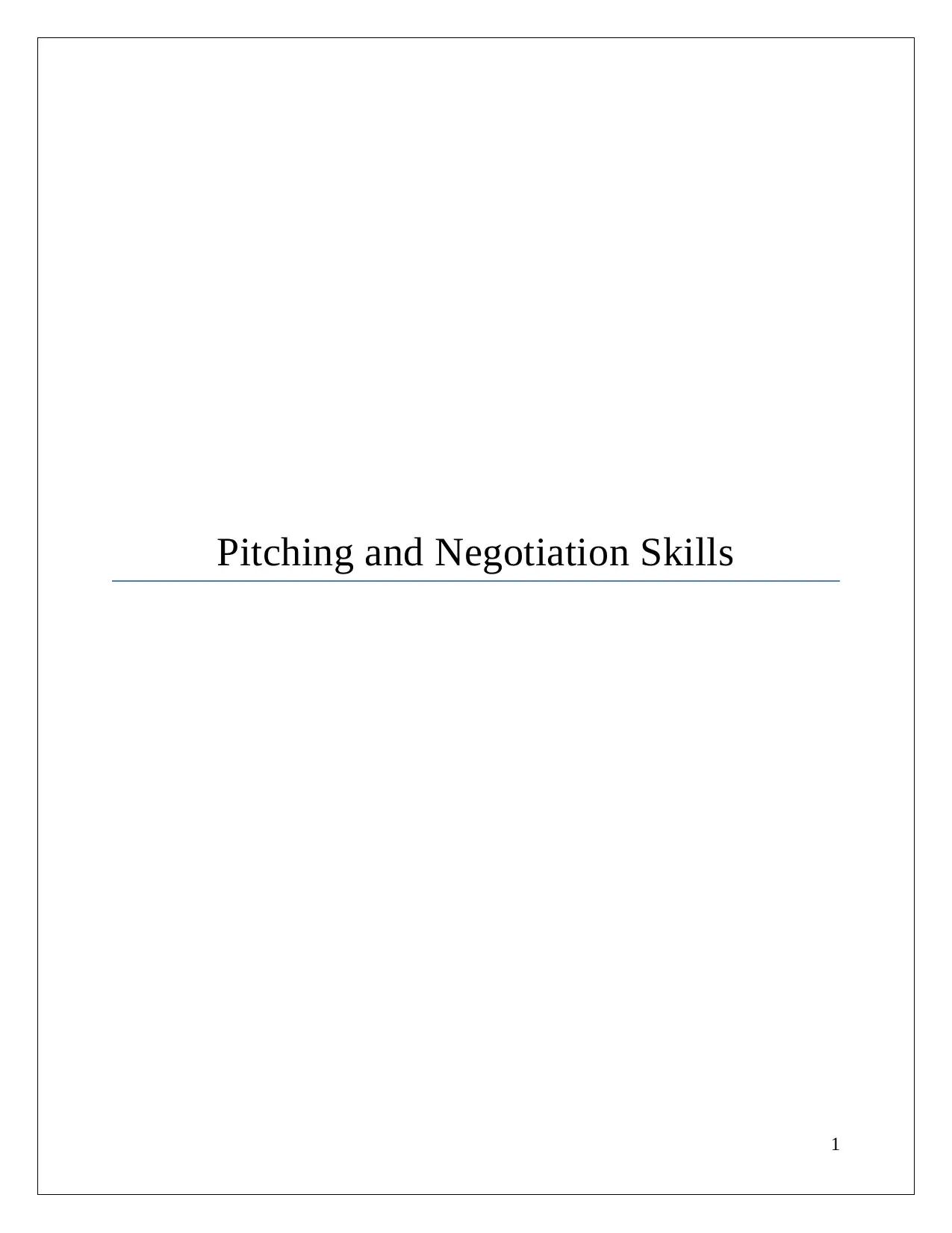
Pitching and Negotiation Skills
1
1
Paraphrase This Document
Need a fresh take? Get an instant paraphrase of this document with our AI Paraphraser

Table of Contents
Introduction......................................................................................................................................4
L01...................................................................................................................................................5
P1: Determine what is a negotiation, why it occurs and who the key stakeholders are during a
negotiation process......................................................................................................................5
P2: Evaluate the key steps and information required for negotiating and generating deals........7
M1: Present a concise rationale for the negotiation process, including detailed steps that
organisations go through during a negotiation process and the information required in
preparation...................................................................................................................................9
D1: Critically evaluate the steps of the negotiation process and present valid solutions for
dealing with issues that can arise...............................................................................................10
LO2................................................................................................................................................11
P3: Explain the RFP process and the relevant types of documentation required......................11
P4: Explain the contractual process and how relevant documentation is managed and
monitored...................................................................................................................................13
M2: Apply the RFP process within an organisational context, outlining the key documentation
required and consequences of breaching the terms of agreement.............................................14
D2 Critically evaluate the competitive tendering and contract process and make
recommendations for completing a successful tender with minimal risk..................................15
LO3................................................................................................................................................16
P5: Develop an appropriate pitch applying key principles that achieve a sustainable
competitive edge........................................................................................................................16
2
Introduction......................................................................................................................................4
L01...................................................................................................................................................5
P1: Determine what is a negotiation, why it occurs and who the key stakeholders are during a
negotiation process......................................................................................................................5
P2: Evaluate the key steps and information required for negotiating and generating deals........7
M1: Present a concise rationale for the negotiation process, including detailed steps that
organisations go through during a negotiation process and the information required in
preparation...................................................................................................................................9
D1: Critically evaluate the steps of the negotiation process and present valid solutions for
dealing with issues that can arise...............................................................................................10
LO2................................................................................................................................................11
P3: Explain the RFP process and the relevant types of documentation required......................11
P4: Explain the contractual process and how relevant documentation is managed and
monitored...................................................................................................................................13
M2: Apply the RFP process within an organisational context, outlining the key documentation
required and consequences of breaching the terms of agreement.............................................14
D2 Critically evaluate the competitive tendering and contract process and make
recommendations for completing a successful tender with minimal risk..................................15
LO3................................................................................................................................................16
P5: Develop an appropriate pitch applying key principles that achieve a sustainable
competitive edge........................................................................................................................16
2
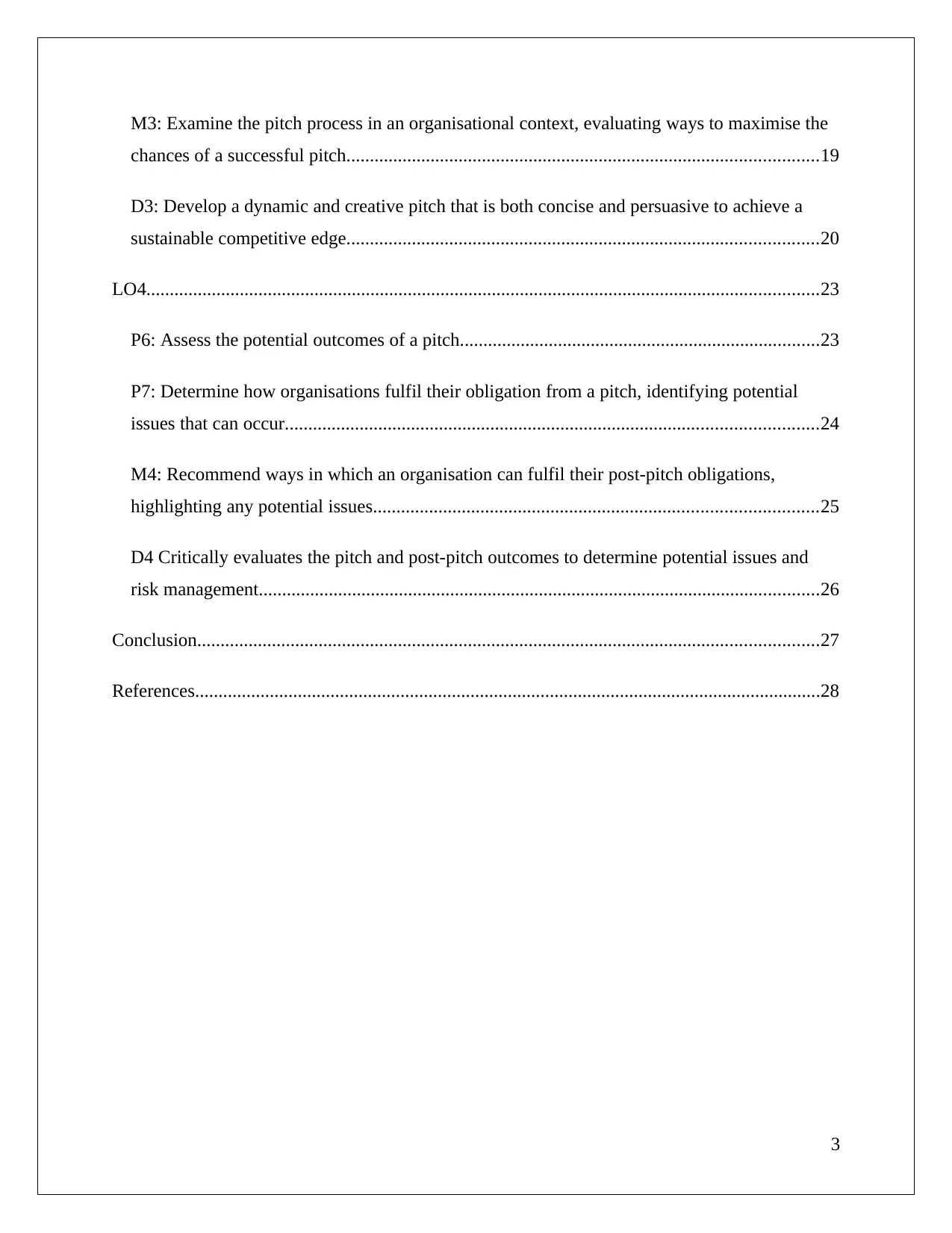
M3: Examine the pitch process in an organisational context, evaluating ways to maximise the
chances of a successful pitch.....................................................................................................19
D3: Develop a dynamic and creative pitch that is both concise and persuasive to achieve a
sustainable competitive edge.....................................................................................................20
LO4................................................................................................................................................23
P6: Assess the potential outcomes of a pitch.............................................................................23
P7: Determine how organisations fulfil their obligation from a pitch, identifying potential
issues that can occur..................................................................................................................24
M4: Recommend ways in which an organisation can fulfil their post-pitch obligations,
highlighting any potential issues...............................................................................................25
D4 Critically evaluates the pitch and post-pitch outcomes to determine potential issues and
risk management........................................................................................................................26
Conclusion.....................................................................................................................................27
References......................................................................................................................................28
3
chances of a successful pitch.....................................................................................................19
D3: Develop a dynamic and creative pitch that is both concise and persuasive to achieve a
sustainable competitive edge.....................................................................................................20
LO4................................................................................................................................................23
P6: Assess the potential outcomes of a pitch.............................................................................23
P7: Determine how organisations fulfil their obligation from a pitch, identifying potential
issues that can occur..................................................................................................................24
M4: Recommend ways in which an organisation can fulfil their post-pitch obligations,
highlighting any potential issues...............................................................................................25
D4 Critically evaluates the pitch and post-pitch outcomes to determine potential issues and
risk management........................................................................................................................26
Conclusion.....................................................................................................................................27
References......................................................................................................................................28
3
⊘ This is a preview!⊘
Do you want full access?
Subscribe today to unlock all pages.

Trusted by 1+ million students worldwide
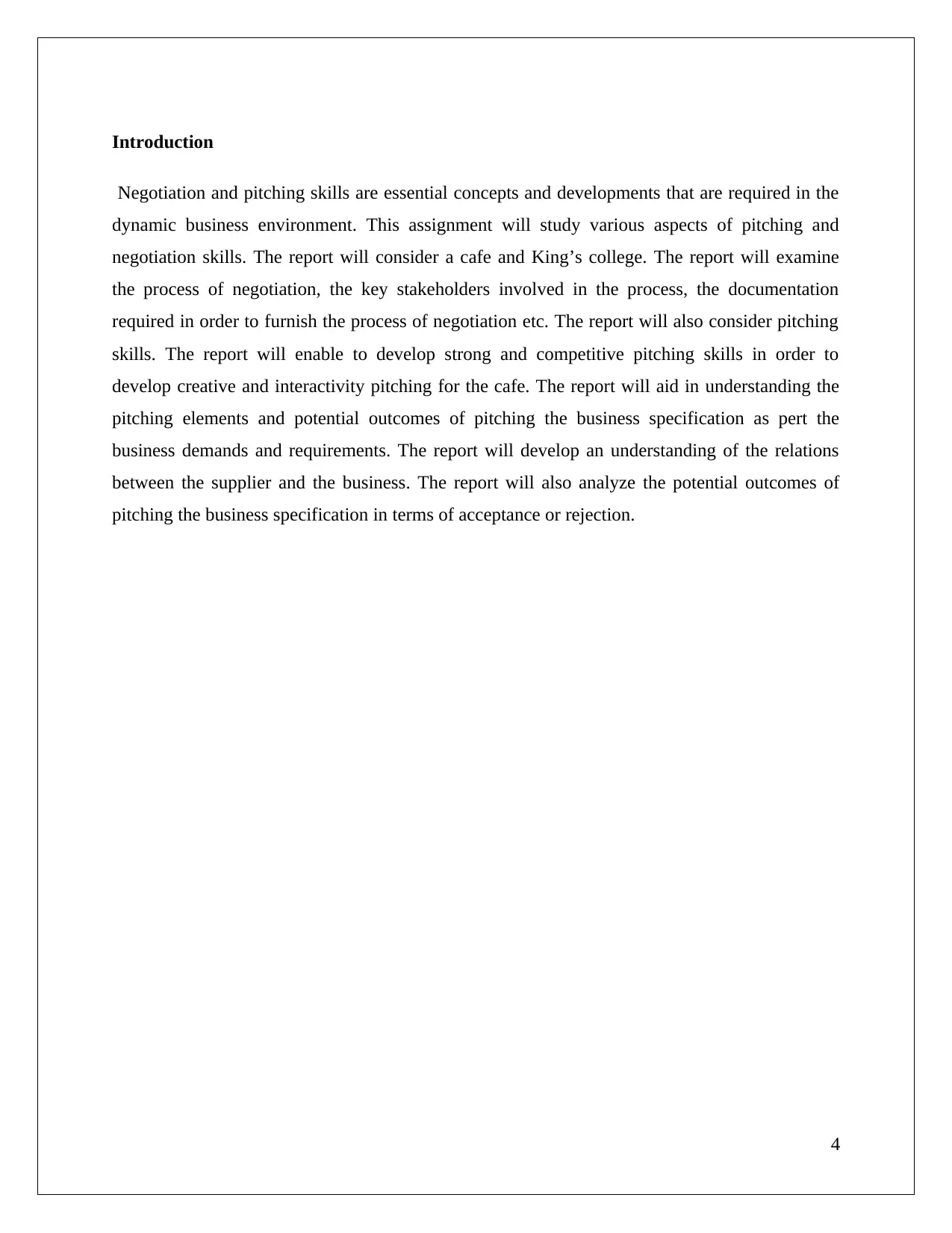
Introduction
Negotiation and pitching skills are essential concepts and developments that are required in the
dynamic business environment. This assignment will study various aspects of pitching and
negotiation skills. The report will consider a cafe and King’s college. The report will examine
the process of negotiation, the key stakeholders involved in the process, the documentation
required in order to furnish the process of negotiation etc. The report will also consider pitching
skills. The report will enable to develop strong and competitive pitching skills in order to
develop creative and interactivity pitching for the cafe. The report will aid in understanding the
pitching elements and potential outcomes of pitching the business specification as pert the
business demands and requirements. The report will develop an understanding of the relations
between the supplier and the business. The report will also analyze the potential outcomes of
pitching the business specification in terms of acceptance or rejection.
4
Negotiation and pitching skills are essential concepts and developments that are required in the
dynamic business environment. This assignment will study various aspects of pitching and
negotiation skills. The report will consider a cafe and King’s college. The report will examine
the process of negotiation, the key stakeholders involved in the process, the documentation
required in order to furnish the process of negotiation etc. The report will also consider pitching
skills. The report will enable to develop strong and competitive pitching skills in order to
develop creative and interactivity pitching for the cafe. The report will aid in understanding the
pitching elements and potential outcomes of pitching the business specification as pert the
business demands and requirements. The report will develop an understanding of the relations
between the supplier and the business. The report will also analyze the potential outcomes of
pitching the business specification in terms of acceptance or rejection.
4
Paraphrase This Document
Need a fresh take? Get an instant paraphrase of this document with our AI Paraphraser
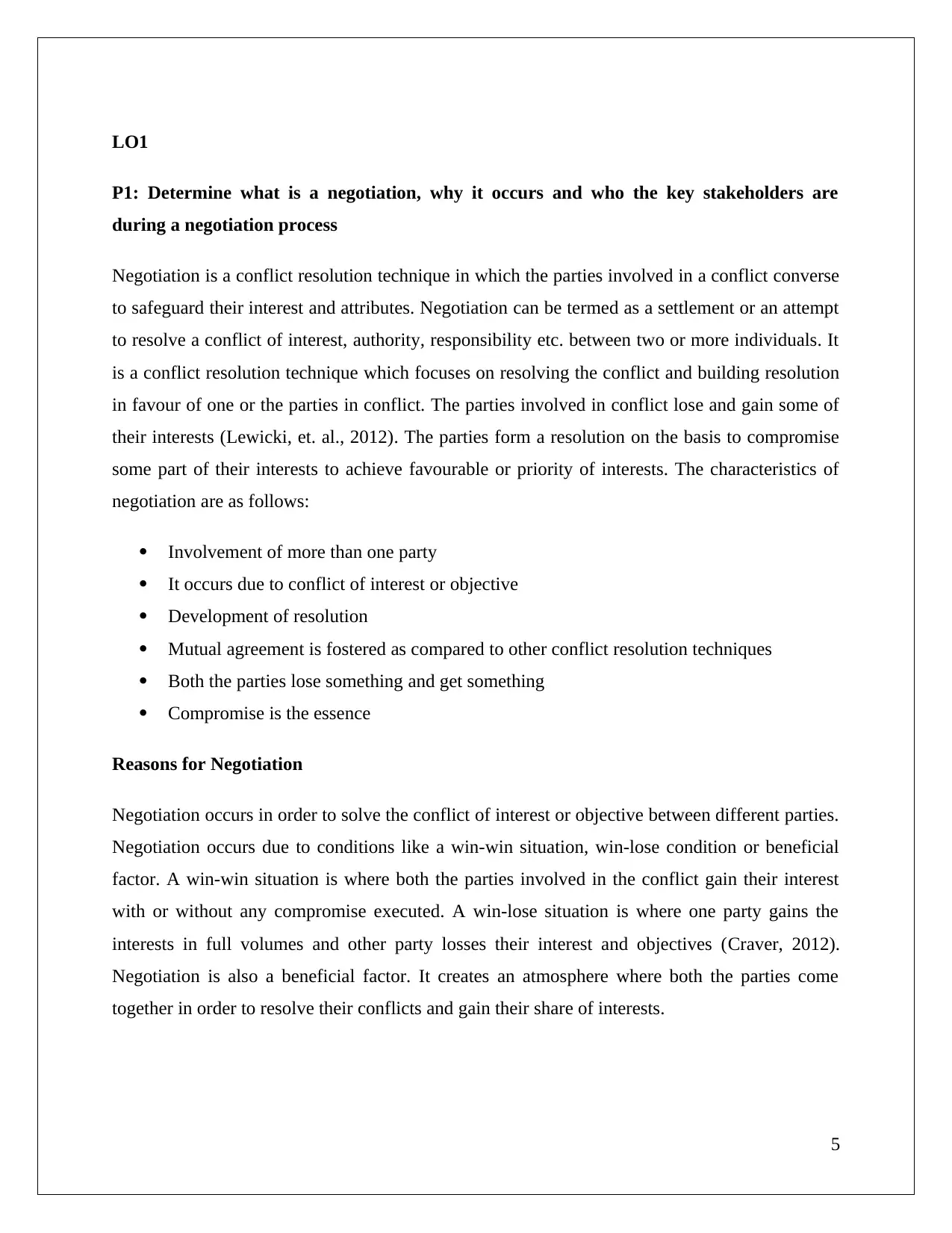
LO1
P1: Determine what is a negotiation, why it occurs and who the key stakeholders are
during a negotiation process
Negotiation is a conflict resolution technique in which the parties involved in a conflict converse
to safeguard their interest and attributes. Negotiation can be termed as a settlement or an attempt
to resolve a conflict of interest, authority, responsibility etc. between two or more individuals. It
is a conflict resolution technique which focuses on resolving the conflict and building resolution
in favour of one or the parties in conflict. The parties involved in conflict lose and gain some of
their interests (Lewicki, et. al., 2012). The parties form a resolution on the basis to compromise
some part of their interests to achieve favourable or priority of interests. The characteristics of
negotiation are as follows:
Involvement of more than one party
It occurs due to conflict of interest or objective
Development of resolution
Mutual agreement is fostered as compared to other conflict resolution techniques
Both the parties lose something and get something
Compromise is the essence
Reasons for Negotiation
Negotiation occurs in order to solve the conflict of interest or objective between different parties.
Negotiation occurs due to conditions like a win-win situation, win-lose condition or beneficial
factor. A win-win situation is where both the parties involved in the conflict gain their interest
with or without any compromise executed. A win-lose situation is where one party gains the
interests in full volumes and other party losses their interest and objectives (Craver, 2012).
Negotiation is also a beneficial factor. It creates an atmosphere where both the parties come
together in order to resolve their conflicts and gain their share of interests.
5
P1: Determine what is a negotiation, why it occurs and who the key stakeholders are
during a negotiation process
Negotiation is a conflict resolution technique in which the parties involved in a conflict converse
to safeguard their interest and attributes. Negotiation can be termed as a settlement or an attempt
to resolve a conflict of interest, authority, responsibility etc. between two or more individuals. It
is a conflict resolution technique which focuses on resolving the conflict and building resolution
in favour of one or the parties in conflict. The parties involved in conflict lose and gain some of
their interests (Lewicki, et. al., 2012). The parties form a resolution on the basis to compromise
some part of their interests to achieve favourable or priority of interests. The characteristics of
negotiation are as follows:
Involvement of more than one party
It occurs due to conflict of interest or objective
Development of resolution
Mutual agreement is fostered as compared to other conflict resolution techniques
Both the parties lose something and get something
Compromise is the essence
Reasons for Negotiation
Negotiation occurs in order to solve the conflict of interest or objective between different parties.
Negotiation occurs due to conditions like a win-win situation, win-lose condition or beneficial
factor. A win-win situation is where both the parties involved in the conflict gain their interest
with or without any compromise executed. A win-lose situation is where one party gains the
interests in full volumes and other party losses their interest and objectives (Craver, 2012).
Negotiation is also a beneficial factor. It creates an atmosphere where both the parties come
together in order to resolve their conflicts and gain their share of interests.
5
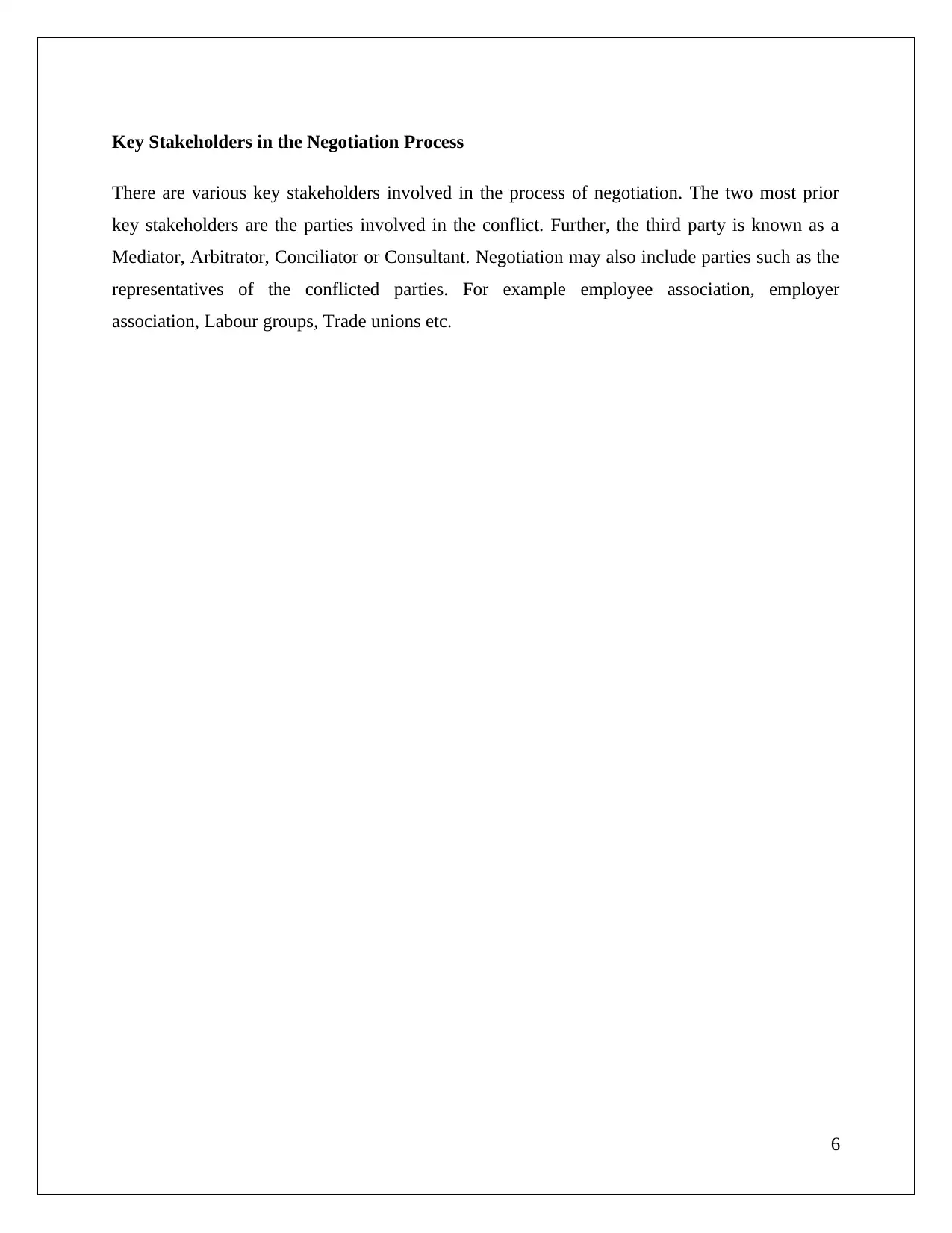
Key Stakeholders in the Negotiation Process
There are various key stakeholders involved in the process of negotiation. The two most prior
key stakeholders are the parties involved in the conflict. Further, the third party is known as a
Mediator, Arbitrator, Conciliator or Consultant. Negotiation may also include parties such as the
representatives of the conflicted parties. For example employee association, employer
association, Labour groups, Trade unions etc.
6
There are various key stakeholders involved in the process of negotiation. The two most prior
key stakeholders are the parties involved in the conflict. Further, the third party is known as a
Mediator, Arbitrator, Conciliator or Consultant. Negotiation may also include parties such as the
representatives of the conflicted parties. For example employee association, employer
association, Labour groups, Trade unions etc.
6
⊘ This is a preview!⊘
Do you want full access?
Subscribe today to unlock all pages.

Trusted by 1+ million students worldwide
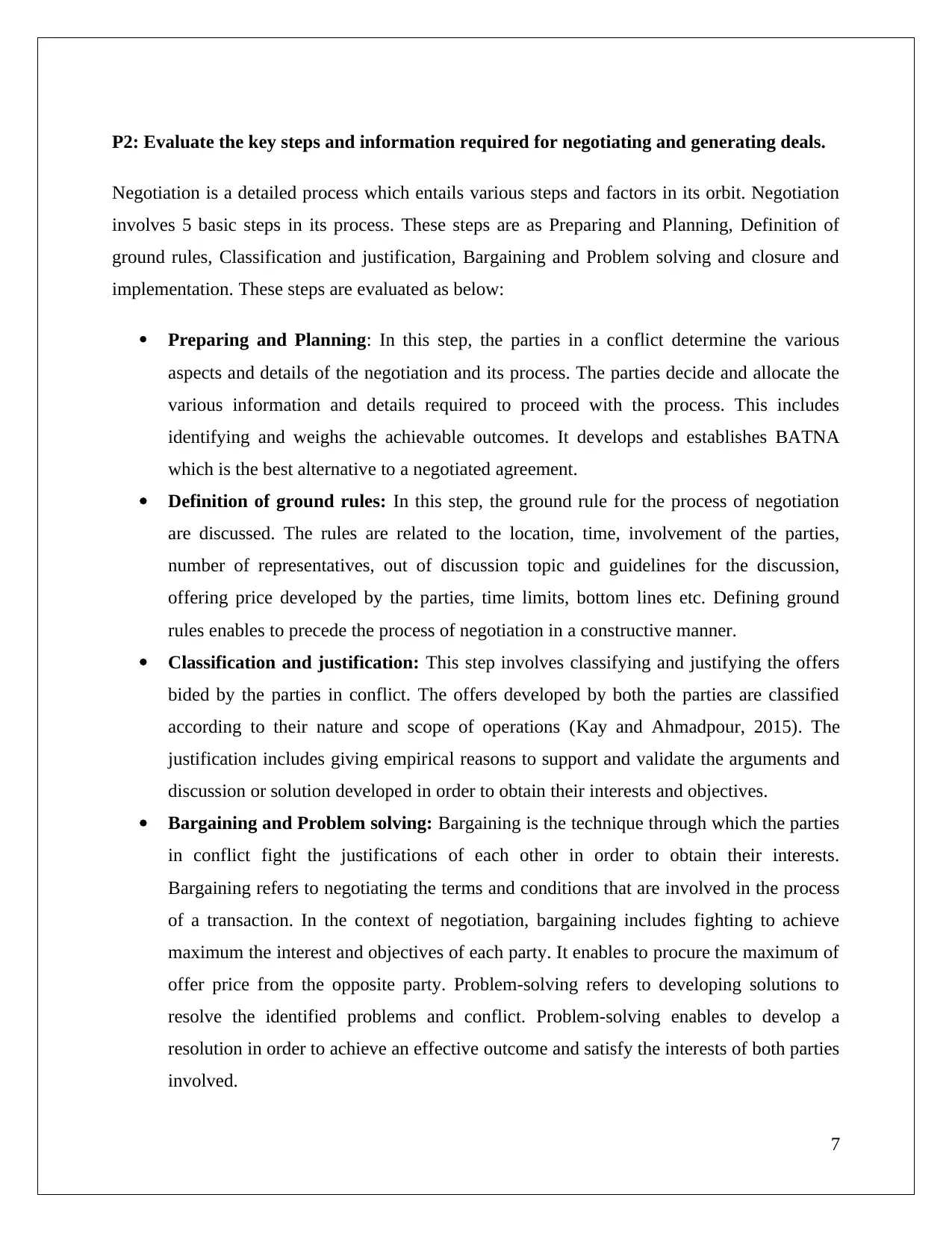
P2: Evaluate the key steps and information required for negotiating and generating deals.
Negotiation is a detailed process which entails various steps and factors in its orbit. Negotiation
involves 5 basic steps in its process. These steps are as Preparing and Planning, Definition of
ground rules, Classification and justification, Bargaining and Problem solving and closure and
implementation. These steps are evaluated as below:
Preparing and Planning: In this step, the parties in a conflict determine the various
aspects and details of the negotiation and its process. The parties decide and allocate the
various information and details required to proceed with the process. This includes
identifying and weighs the achievable outcomes. It develops and establishes BATNA
which is the best alternative to a negotiated agreement.
Definition of ground rules: In this step, the ground rule for the process of negotiation
are discussed. The rules are related to the location, time, involvement of the parties,
number of representatives, out of discussion topic and guidelines for the discussion,
offering price developed by the parties, time limits, bottom lines etc. Defining ground
rules enables to precede the process of negotiation in a constructive manner.
Classification and justification: This step involves classifying and justifying the offers
bided by the parties in conflict. The offers developed by both the parties are classified
according to their nature and scope of operations (Kay and Ahmadpour, 2015). The
justification includes giving empirical reasons to support and validate the arguments and
discussion or solution developed in order to obtain their interests and objectives.
Bargaining and Problem solving: Bargaining is the technique through which the parties
in conflict fight the justifications of each other in order to obtain their interests.
Bargaining refers to negotiating the terms and conditions that are involved in the process
of a transaction. In the context of negotiation, bargaining includes fighting to achieve
maximum the interest and objectives of each party. It enables to procure the maximum of
offer price from the opposite party. Problem-solving refers to developing solutions to
resolve the identified problems and conflict. Problem-solving enables to develop a
resolution in order to achieve an effective outcome and satisfy the interests of both parties
involved.
7
Negotiation is a detailed process which entails various steps and factors in its orbit. Negotiation
involves 5 basic steps in its process. These steps are as Preparing and Planning, Definition of
ground rules, Classification and justification, Bargaining and Problem solving and closure and
implementation. These steps are evaluated as below:
Preparing and Planning: In this step, the parties in a conflict determine the various
aspects and details of the negotiation and its process. The parties decide and allocate the
various information and details required to proceed with the process. This includes
identifying and weighs the achievable outcomes. It develops and establishes BATNA
which is the best alternative to a negotiated agreement.
Definition of ground rules: In this step, the ground rule for the process of negotiation
are discussed. The rules are related to the location, time, involvement of the parties,
number of representatives, out of discussion topic and guidelines for the discussion,
offering price developed by the parties, time limits, bottom lines etc. Defining ground
rules enables to precede the process of negotiation in a constructive manner.
Classification and justification: This step involves classifying and justifying the offers
bided by the parties in conflict. The offers developed by both the parties are classified
according to their nature and scope of operations (Kay and Ahmadpour, 2015). The
justification includes giving empirical reasons to support and validate the arguments and
discussion or solution developed in order to obtain their interests and objectives.
Bargaining and Problem solving: Bargaining is the technique through which the parties
in conflict fight the justifications of each other in order to obtain their interests.
Bargaining refers to negotiating the terms and conditions that are involved in the process
of a transaction. In the context of negotiation, bargaining includes fighting to achieve
maximum the interest and objectives of each party. It enables to procure the maximum of
offer price from the opposite party. Problem-solving refers to developing solutions to
resolve the identified problems and conflict. Problem-solving enables to develop a
resolution in order to achieve an effective outcome and satisfy the interests of both parties
involved.
7
Paraphrase This Document
Need a fresh take? Get an instant paraphrase of this document with our AI Paraphraser

Closure and Implementation: In this step, the negotiation outcome developed is
implemented on to the parties and the process of negotiation is closed.
The information required to generate deals is as follows:
The history and background information of the parties involved.
Various documents and evidence regarding the conflict and the dispute.
The price offered by both the parties.
The discussion of bottom line regarding the offer
The contract of negotiation
The details of previous contracts and other agreements.
Objective and interests of both the parties.
8
implemented on to the parties and the process of negotiation is closed.
The information required to generate deals is as follows:
The history and background information of the parties involved.
Various documents and evidence regarding the conflict and the dispute.
The price offered by both the parties.
The discussion of bottom line regarding the offer
The contract of negotiation
The details of previous contracts and other agreements.
Objective and interests of both the parties.
8

M1: Present a concise rationale for the negotiation process, including detailed steps that
organisations go through during a negotiation process and the information required in
preparation.
The process of negotiation includes steps such as preparation and planning, defining of ground
rules, clarification and justification, bargaining and problem solving, closure and
implementation. These steps are logical due in the series. The step of preparation and planning
provides with all the details and information required in order to plan the process of negotiation.
The step of defining ground rules is appropriate as it lays down all the details and rules according
to which the process will be executed (Moore, 2014). The step of clarification and justification is
also important as it provides an opportunity to clarify and justify the offer prices and conflict
interests. The step of bargaining and problem solving enables to bargain and achieve the
maximum of interests and enables to develop effective problem-solving remedies. The last step
of closure and implementation executes the most effective implementation of the negotiation and
its outcomes on the parties involved in the conflict.
9
organisations go through during a negotiation process and the information required in
preparation.
The process of negotiation includes steps such as preparation and planning, defining of ground
rules, clarification and justification, bargaining and problem solving, closure and
implementation. These steps are logical due in the series. The step of preparation and planning
provides with all the details and information required in order to plan the process of negotiation.
The step of defining ground rules is appropriate as it lays down all the details and rules according
to which the process will be executed (Moore, 2014). The step of clarification and justification is
also important as it provides an opportunity to clarify and justify the offer prices and conflict
interests. The step of bargaining and problem solving enables to bargain and achieve the
maximum of interests and enables to develop effective problem-solving remedies. The last step
of closure and implementation executes the most effective implementation of the negotiation and
its outcomes on the parties involved in the conflict.
9
⊘ This is a preview!⊘
Do you want full access?
Subscribe today to unlock all pages.

Trusted by 1+ million students worldwide

D1: Critically evaluate the steps of the negotiation process and present valid solutions for
dealing with issues that can arise.
The process of negotiation is a beneficial process which enables the parties in conflict to fetch
their interests and objectives. This process benefits both the parties and develops an effective
negotiated outcome. The process is a conflict resolution technique and provides an advantage of
procuring the interests and objectives rather than fighting the opposition party.
On the other hand, there are various issue and demerits of this process. The process of negotiation
is not legally binding on the parties involved in the conflict resolution (Kay and Ahmadpour,
2015). The process is time-consuming and has a high risk to lead towards unwanted and
unnecessary discussions. The process lacks the attribute of legal implications of non-compliance
and thus leads to a waste of time activity in the case of failure in execution.
The issue involved in the process of negotiation can be handled in the following manners:
Involvement of the Mediator or Consultant
Binding Legal implications for non-compliance
Limiting the areas of discussion
Executing the negotiated outcomes effectively
10
dealing with issues that can arise.
The process of negotiation is a beneficial process which enables the parties in conflict to fetch
their interests and objectives. This process benefits both the parties and develops an effective
negotiated outcome. The process is a conflict resolution technique and provides an advantage of
procuring the interests and objectives rather than fighting the opposition party.
On the other hand, there are various issue and demerits of this process. The process of negotiation
is not legally binding on the parties involved in the conflict resolution (Kay and Ahmadpour,
2015). The process is time-consuming and has a high risk to lead towards unwanted and
unnecessary discussions. The process lacks the attribute of legal implications of non-compliance
and thus leads to a waste of time activity in the case of failure in execution.
The issue involved in the process of negotiation can be handled in the following manners:
Involvement of the Mediator or Consultant
Binding Legal implications for non-compliance
Limiting the areas of discussion
Executing the negotiated outcomes effectively
10
Paraphrase This Document
Need a fresh take? Get an instant paraphrase of this document with our AI Paraphraser
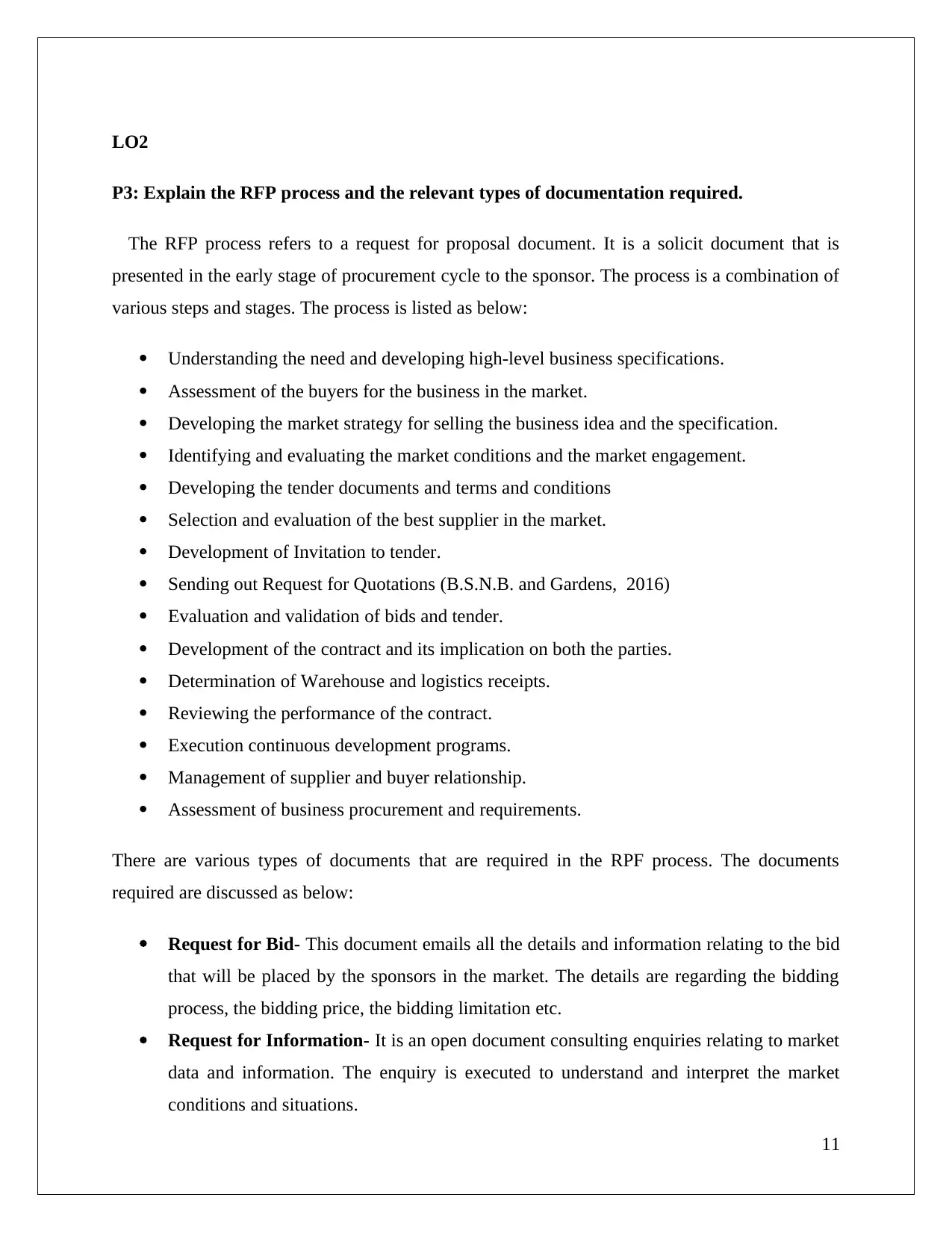
LO2
P3: Explain the RFP process and the relevant types of documentation required.
The RFP process refers to a request for proposal document. It is a solicit document that is
presented in the early stage of procurement cycle to the sponsor. The process is a combination of
various steps and stages. The process is listed as below:
Understanding the need and developing high-level business specifications.
Assessment of the buyers for the business in the market.
Developing the market strategy for selling the business idea and the specification.
Identifying and evaluating the market conditions and the market engagement.
Developing the tender documents and terms and conditions
Selection and evaluation of the best supplier in the market.
Development of Invitation to tender.
Sending out Request for Quotations (B.S.N.B. and Gardens, 2016)
Evaluation and validation of bids and tender.
Development of the contract and its implication on both the parties.
Determination of Warehouse and logistics receipts.
Reviewing the performance of the contract.
Execution continuous development programs.
Management of supplier and buyer relationship.
Assessment of business procurement and requirements.
There are various types of documents that are required in the RPF process. The documents
required are discussed as below:
Request for Bid- This document emails all the details and information relating to the bid
that will be placed by the sponsors in the market. The details are regarding the bidding
process, the bidding price, the bidding limitation etc.
Request for Information- It is an open document consulting enquiries relating to market
data and information. The enquiry is executed to understand and interpret the market
conditions and situations.
11
P3: Explain the RFP process and the relevant types of documentation required.
The RFP process refers to a request for proposal document. It is a solicit document that is
presented in the early stage of procurement cycle to the sponsor. The process is a combination of
various steps and stages. The process is listed as below:
Understanding the need and developing high-level business specifications.
Assessment of the buyers for the business in the market.
Developing the market strategy for selling the business idea and the specification.
Identifying and evaluating the market conditions and the market engagement.
Developing the tender documents and terms and conditions
Selection and evaluation of the best supplier in the market.
Development of Invitation to tender.
Sending out Request for Quotations (B.S.N.B. and Gardens, 2016)
Evaluation and validation of bids and tender.
Development of the contract and its implication on both the parties.
Determination of Warehouse and logistics receipts.
Reviewing the performance of the contract.
Execution continuous development programs.
Management of supplier and buyer relationship.
Assessment of business procurement and requirements.
There are various types of documents that are required in the RPF process. The documents
required are discussed as below:
Request for Bid- This document emails all the details and information relating to the bid
that will be placed by the sponsors in the market. The details are regarding the bidding
process, the bidding price, the bidding limitation etc.
Request for Information- It is an open document consulting enquiries relating to market
data and information. The enquiry is executed to understand and interpret the market
conditions and situations.
11
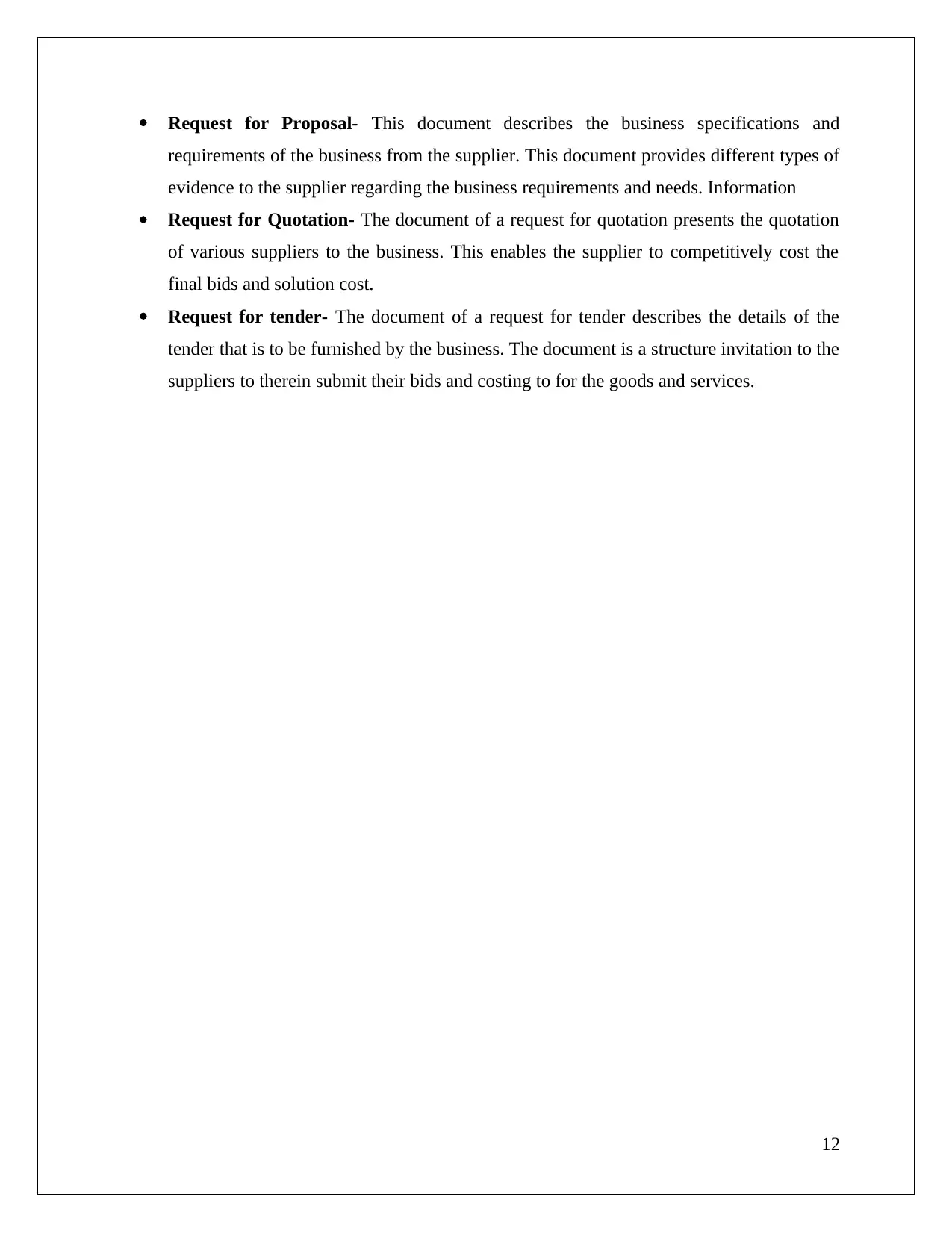
Request for Proposal- This document describes the business specifications and
requirements of the business from the supplier. This document provides different types of
evidence to the supplier regarding the business requirements and needs. Information
Request for Quotation- The document of a request for quotation presents the quotation
of various suppliers to the business. This enables the supplier to competitively cost the
final bids and solution cost.
Request for tender- The document of a request for tender describes the details of the
tender that is to be furnished by the business. The document is a structure invitation to the
suppliers to therein submit their bids and costing to for the goods and services.
12
requirements of the business from the supplier. This document provides different types of
evidence to the supplier regarding the business requirements and needs. Information
Request for Quotation- The document of a request for quotation presents the quotation
of various suppliers to the business. This enables the supplier to competitively cost the
final bids and solution cost.
Request for tender- The document of a request for tender describes the details of the
tender that is to be furnished by the business. The document is a structure invitation to the
suppliers to therein submit their bids and costing to for the goods and services.
12
⊘ This is a preview!⊘
Do you want full access?
Subscribe today to unlock all pages.

Trusted by 1+ million students worldwide
1 out of 29
Related Documents
Your All-in-One AI-Powered Toolkit for Academic Success.
+13062052269
info@desklib.com
Available 24*7 on WhatsApp / Email
![[object Object]](/_next/static/media/star-bottom.7253800d.svg)
Unlock your academic potential
Copyright © 2020–2025 A2Z Services. All Rights Reserved. Developed and managed by ZUCOL.



